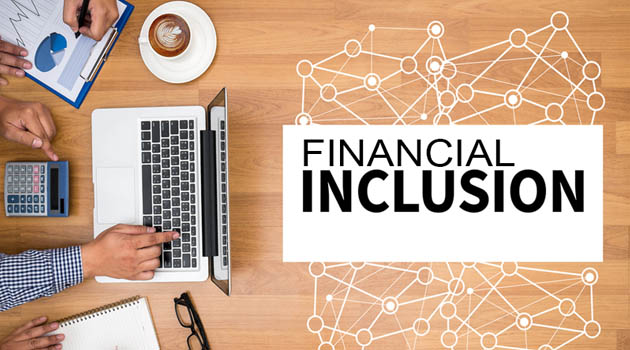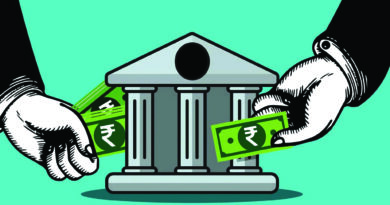FINANCIAL INCLUSION – NEW INITIATIVES AND CHALLENGES
Financial inclusion is delivery of banking services at an affordable cost to the vast sections of disadvantaged and low income groups. The banking service should be available to the entire population without discrimination. The inclusion can happen through voluntary effort of banks by engaging various strategies to include large strata of the society in their operations. Government and Reserve Bank of India step in and give directions so that the financial inclusion is a reality. For many, the financial inclusion means having a saving bank account without frills.
Financial inclusion [FI] refers to the policy goal of providing a full range of formal financial services [savings, credit, insurance, remittance] to all financially excluded households without discrimination. Affordable price, delivery with dignity, convenience, reliability, flexibility and continuity determine the quality of financial access. Financially excluded are those who are denied access to even the most basics of financial products. It is a statutory right to have a bank account in France. At present the focus of the financial inclusion is confined to ensure a bare minimum access to a savings bank account without frills to all. However, internationally, having a bank account is not regarded as an accurate indicator of financial inclusion. The Financial Inclusion Task Force in UK has identified three priority areas for the purpose of financial inclusion namely access to banking, access to affordable credit and access to free face to face money advice. The Community Reinvestment Act (CRA) in the United States prohibits discrimination by banks against low and moderate income neighborhoods. Various studies conducted by Harvard University demonstrated that CRA lending is a win-win proposition and profitable to banks.
The bank nationalization in India resulted in a shift in the focus of banking from class banking to mass banking. However, households in the North Eastern states availing banking services was very less since it was only 29.6% in Manipur and 37.5% in Meghalaya whereas it amounted to 74.2% in Kerala and 86.8% in Goa.
Table 1
Households Availing Banking Services
|
Sl.No |
State |
Total No. of Households |
Percentage of Households availing banking services | Percentage of households having mobile/Land line | Percentage of households having mobile phone |
| 1 | Andhra Pradesh | 2,10,24,534 | 53.1 | 63.1 | 54.9 |
| 2 | Assam | 63,67,295 | 44.1 | 47.9 | 43.5 |
| 3 | Bihar | 1,89,40,629 | 44.4 | 55.5 | 51.6 |
| 4 | West Bengal | 2,00,67,299 | 48.8 | 49.2 | 42.9 |
| 5 | Goa | 3,22,813 | 86.8 | 89.1 | 53.8 |
| 6 | Gujarat | 1,21,81,718 | 57.9 | 69.0 | 58.6 |
| 7 | Kerala | 77,16,370 | 74.2 | 89.7 | 46.8 |
| 8 | Karnataka | 1,31,79,911 | 61.1 | 71.6 | 56.5 |
| 9 | Maharashtra | 2,38,30,580 | 68.9 | 69.1 | 53.7 |
| 10 | Odisha | 9,6,61,085 | 45.0 | 39.8 | 35.6 |
| 11 | Rajasthan | 1,25,81,303 | 68.0 | 70.6 | 62.5 |
| 12 | Punjab | 54,09,699 | 65.2 | 82.1 | 62.3 |
| 13 | Tamil Nadu | 1,84,93,003 | 52.5 | 74.9 | 62.1 |
| 14 | Uttar Pradesh | 3,29,24,266 | 72.0 | 66.9 | 61.2 |
| 15 | Manipur | 5,07,152 | 29.6 | 57.5 | 52.3 |
| 16 | Meghalaya | 5,38,299 | 37.5 | 43.0 | 39.1 |
| 17 | Haryana | 47,17,954 | 68.1 | 79.3 | 66.9 |
| National Capital Territory Delhi | 33,40,538 | 77.7 | 90.8 | 68.3 | |
| ALL INDIA | 24,66,92,667 | 58.7 | 63.2 | 53.2 | |
Source: Census Report on Household Amenities and Assets 2011 released on 13th March 2012.
The percentage of households availing banking services in India amounted to 58.7% in 2011 and the percentage of households having mobile/land line was 63.2%. The census report further revealed that 68 per cent of urban households availed banking services whereas it was only 54 per cent in the case of rural households. Financial inclusion commenced in India in November 2005 when the Reserve bank advised banks to make available a basic banking ‘no frills’ account with low or nil minimum balance as well as charges. The new policy of the Government and Reserve Bank of India places a lot of emphasis on the efforts to achieve financial inclusion through better banking penetration and outreach.
The number of telephone subscribers in India increased to 893.15 million at the end of January 2013 of which 340.60 million subscribers are in rural areas. Thus the overall teledensity in India reached to 73.07 and the rural teledensity was 40.07 at the end of January 2013. (www.trai.gov.in). This suggests how best mobile phone potential can be harnessed to connect un-banked population and achieve Financial Inclusion. Acknowledging these facts Government & RBI initiated policy for FI which banks have been implementing successfully. In the Union Budget of 2007-‘08, the Government announced the creation two funds namely (i) Financial Inclusion Fund and (ii) Financial Inclusion Technology Development Fund for meeting the costs of Development and promotional and technology interventions as recommended by the Rangarajan Committee. Some of the initiatives in the direction of financial inclusion include Kisan Credit cards, Micro Finance, Self Help Group (SHG), SEWA bank in Gujarat etc. Acknowledging the importance of FI public sector banks in particular have significantly responded with regard to:-
- Appointing and training Business Correspondents [BCs]
- Reaching all unbanked villages above a population of 2000 and preparing roadmap to provide banking services under Financial Inclusion Plan [FIP].
- Planned to cover additional 43,381 in 2012 and also cover adjoining villages with population between 1000 and 2000 to optimally utilize FI infrastructure created by investing in technology, manpower, and BCs. FIPs include strategy adopted for enrolling and training BCs and branch managers, technology plans, awareness generation plans and monitoring mechanism.
Government Initiatives for Financial Inclusion:
1. Spread of ATM
The total number of ATMs installed in India was 1,11,493 as on 15th March 2013 (according to the National Payment Corporation of India web site). The Finance Ministry has asked public sector banks to work out the modalities of joint sourcing of ATMs, State/district wise and the idea behind the joint sourcing of ATMs is to drive down the cost of transactions and also encourage banks to set up ATMs in unbanked rural areas. The government wants public sector banks to expand ATMs in rural areas so that the rural folks can withdraw the subsidy and entitlement transfers given by the Central Government, which add up to over Rs 2 lakh crore annually.
Table No 2
Table Showing Physical Access
|
Country |
ATMs per hundred thousand adults | ATMs per thousand km2 | Branches per hundred thousand adults | POSs per hundred thousand adults |
| Australia | 156.69 | 3.52 | 31.86 | 4039.64 |
| Brazil | 112.06 | 18.73 | 12.71 | 2247.41 |
| Canada | 218.55 | 6.66 | 24.11 | 2556.01 |
| France | 105.27 | 96.89 | 43.21 | 2456.92 |
| Germany | 112.18 | 228.00 | 15.91 | 8 36.53 |
| India | 7.29 | 19.08 | 10.11 | 67.06 |
| Russia | 76.51 | 5.65 | 2.62 | 293.05 |
| United Kingdom | 122.84 | 257.07 | 22.74 | 2330.70 |
Source: Consultative Group to Assist the Poor, Financial Indicators, 2010. www.cgap.org/financial indicators-physical outreach.
“Although there has been about 30 per cent year-on-year growth in the number of ATMs deployed in the country since 2008, ATM penetration on a per capita basis continues to be less compared to other countries. “There is, therefore, an abundant scope and a felt need to deploy more ATMs, since India stands far behind other developed countries (see table No.2)
2. Integra’s Mobile Financial Applications Secure Terminal (iMFAST)
Integra’s Mobile Financial Applications Secure Terminal extends banking to “financially excluded” rural India, overcoming the challenges of power and connectivity. It identifies and authenticates the user, facilitates voice-guided transactions and prints receipt for each transaction. It represents the evolution of newer systems for rural environments capable of lowering the cost per transaction. iMFAST was designed to address the specific pains of rural banking. It is designed to be transported to the villages by an agent (who may work for the bank or a postal service) and who can visit multiple villages in a day. The small portable compact electronic device brings in cash into the banking system through cashless transactions. It has a secure identification and authentication system through a live biometric fingerprint sensor. The device has local language voice guided systems and offers both, wired and wireless connectivity.
3. Micro ATM Device:
With a view to further simplify the process of delivering wages to daily workers (such as those enrolled under MG-NREGA scheme), the Unique Identification Authority of India (UIDAI) has launched a micro ATM device which will enable beneficiaries to withdraw money at their doorsteps. All one has to do is place his/her finger on the micro ATM wireless device and key in his/her Aadhaar number and get the money from the business correspondent after he verifies the balance in beneficiary’s bank account. The entire process is said to take 8-10 seconds to complete. The micro-ATM device is expected to prove extremely useful to those residing in far-flung corners of the country where villagers often need to travel long distances to withdraw money or access any other banking services. The UIDAI is also planning to introduce the system in areas like telecom, public distribution system, LPG cylinder and fertilizer/kerosene.
4. White Label ATM
It has been decided by the government of India to permit non-banks to set up, own and operate ATMs to accelerate the growth and penetration of ATMs in the country. Such ATMs will be in the nature of White Label ATMs (WLA) and would provide ATM services to customers of all banks. .
5. Business Correspondents:
The business correspondents appointed by the bank who is personally know to the villagers, go from house to house in the rural areas and collects small amounts of money and deposits them in the bank nearby. He hands over the pass book to the villagers after having made entries by the bank official. BCs deployed- tripled in 2 years from 3,042 in 2009-10 to 9,682 in 2011-12.
6. Ultra Small Branches: –
Furthering financial inclusion in unbanked rural areas, the Reserve Bank of India has allowed banks to establish ‘ultra small branches’ in rural centres from where Business Correspondents (BCs) can conduct operations on behalf of banks. “These BC outlets may be in the form of low-cost simple brick and mortar structures,” the RBI said in a notification. Every BC is under the oversight of a base branch. The base branch will have to provide oversight to the BC outlets which will include periodic visits by officers of the base branch to these outlets and to other places of functioning of BCs. BCs are permitted to carry out transactions on behalf of the bank as agents, and they can refer clients, pursue the clients’ proposal and facilitate the bank to carry out its transactions. The RBI said these ultra small branches may be set up between the base branch and BC locations to provide support to about 8-10 BC units at a distance of 3-4 km
7. Post Office Banking:
Post offices across the country will become part of the Core Banking Solution and will offer real-time banking solutions. This was announced by the Finance Minister Mr. P. Chidambaram and he proposed an investment of Rs 532 crore for the project in 2013-14. Once when the deployment is done, which is expected to start in a phased manner as the Indian Postal Network consists around 1.55 lakh post offices and CBS deployment will clearly empower it to offer a broad range of services like Internet Banking, ATMs, Mobile and other innovative services.
India Post’s reach is bigger than the 75,000 branches (just 22,000 rural) of all scheduled commercial banks put together. Indian will be following the example from Japan’s post office, which is the largest holder of personal savings in the world, offering banking and life insurance services, apart from selling stamps and delivering letters. Its unique outreach would equip it to serve social objectives. India Post has a clear advantage over banks as a vehicle for promoting financial inclusion. With less than 40 per cent of the rural households covered by institutional lending, the potential of the post office to address the crisis of credit in rural India can hardly be over emphasized. Its financial inclusion potential has already come to the fore in the context of implementation of the Mahatma Gandhi National Rural Employment Guarantee Scheme, where 46.7 million accounts had been opened and wages amounting to over Rs 18,000 crore had been distributed as on 31st October 2011.
8. Unique Identification Authority of India (UIDAI)
While the banks will authorize the transaction, the authentication will be done by UIDAI by biometric association with its database. The UIDAI is also considering giving unbanked citizens the option to receive a pre-paid payment card issued by banks which can be used for channeling payments from government schemes, including National Rural Employment Guarantee Act. “The plan is to have at least two micro-ATMs in every village for effective implementation of financial inclusion.
No-frill accounts (Basic Savings Account): Yet another initiative for financial inclusion was the opening of No Frill Accounts, including through Business Correspondent -ICT, EBT, Kisan Credit Card, General Credit Card etc. The No-Frill Accounts opened during the year ended 31st march 2010 was 49.33 million whereas the No-Frill Accounts opened during the year ended 31st March 2011 was to 103.21 million. (See Table No. 3) Nearly 100 Million no frills accounts have been opened by banks so far.
Measures initiated by banks to promote Financial Inclusion in rural areas.
- SBI developed a mobile banking kit [‘bank in a box’] and introduced Tiny Smart Cards for SHG customers. Tiny Cards support Savings Bank, Recurring Deposit, S.B -Cum-Overdraft and Remittance products. SBI, since August 2010, introduced SBI Tatkal, an instant money transfer service. Once the transaction is completed the sender and the recipient receive a confirmation SMS on the mobile numbers registered. The target segment for this product includes migrant laborers, daily wage workers, self-employed and small entrepreneurs working in the cities. .
- HDFC Bank’s ‘Anywhere Bank Terminal’ at locations of BCs, besides ‘Bank on Wheels’ launched in 13 States [including Bihar, M.P. Rajasthan and U.P] exclusively for the rural market to facilitate low-income unbanked & underprivileged households to access financial services at affordable cost at their door. PNB has set up 30 Banking Kiosks in Bihar, Haryana and UP providing banking services through ICT based BC models. Bank provides smart cards/KCC/GCC, no-frills account with overdraft facility to at least one member of the household in villages under Outreach Program of RBI.
- Indian Bank launched Mobile branch [van] with ATM facility and coin vending machine at Jangipur [West Bengal] & Vellore [Tamil Nadu] to provide banking services to villages…
- To accelerate FI process Canara Bank has taken technology initiatives viz. multi-lingual biometric ATMs, Voice-enabled mobile biometric ATM and Smart Cards. To create awareness about banking facilities and Bank’s products among rural households, the Bank has deployed ‘Gramin Vikas Vahini’ in 35 districts.
- Syndicate bank has adopted Mobile technology as well as Smart Card technology. Bank’s micro-ATMs are as per IDBRT specified standards. It has designed Micro-insurance product with Tata-AIG providing risk cover of Rs.25,000 @ premium of Rs.30 plus tax per annum meant for the rural poor.
- Corporation Bank initiated pilot projects on branchless banking in Karnataka, Andhra Pradesh, Tamil Nadu and Goa, surveyed 1200 villages during 2009-10 and assisted rural households to open bank accounts and issued Smart Cards to 5.47 lakh customers.
- Union Bank of India serves thousands of customers in remote villages through its BCs, such as Infrastructure Leasing and Financial Services, Drishti and Basix.
- Under NREGS, banks in Andhra Pradesh conducted pilot projects to test ‘leakage proof’’ routing payments to beneficiaries’ accounts and transfer payments to the laborers through smart card-based savings accounts.
- Zero-Mass Foundation launched a new generation biometric fingerprint authentication-based solution, which has reached five million customers including beneficiaries of social security, pension scheme, NREGS and SHG members.
- mChek provides services which include bank deposits, withdrawal, loan repayments, account balance and grocery payments. mChek has a vision to bring the entire ecosystem of partners across the banking sector, banking service providers, as well as telecom operators to serve the base users.
- In 2009 MYRADA with the support of NABARD developed NAB YUKTI, software to generate simplified MIS for promoting and linking SHGs with banks
- BASIX in collaboration with banks has set up physical infrastructure in the form of Kiosks, which provide financial services and help rural households secure essentials and maintain contact with external world through internet connectivity.
Table 3
Financial Inclusion Plan’s Achievements at a Glance:
|
Particulars |
Year ended
March 2010 |
Year ended
March 2011 |
Year ended
March 2012 |
| No. of BCs/BC Agents Deployed | 33,042 | 96,828 | 63,786 |
| Banking Outlets through Branches | 21,475 | 24,701 | 3,226 |
| Banking Outlets through BCs | 32,684 | 1,20,355 | 87,671 |
| Banking Outlets-Through other Modes | 99 | 2,478 | 2,379 |
| Total Banking Outlets | 54,258 | 1,47,534 | 93,276 |
| No Frill A/Cs (No. in Millions) | 49.33 | 103.21 | 53.88 |
| Overdraft- No Frill A/Cs (No. in Millions) | 0.13 | 1.52 | 1.39 |
| BC- ICT Based A/Cs (No. in Millions) | 12.54 | 52.07 | 39.53 |
| EBT A/Cs-through BCs (No. in Millions) | 7.48 | 21.76 | 14.28 |
| KCC(No. in Millions) | 17.63 | 22.34 | 4.71 |
| GCC(No. in Millions) | 0.45 | 1.27 | 0.82 |
Source: Financial inclusion update, Reserve Bank of India 8th June, 2012.
Issues and Challenges of Financial Inclusion: The greatest challenge in financial inclusion is the Demographic Spread. A major issue bothering the authorities is how to provide banking services to villages with low population and its viability. Hence an appropriate Business Model is yet to be evolved which makes available suitable products with efficient delivery mechanism. Lack of financial literacy is yet another issue to be looked into so that. ICT based model can get stabilized. Yet another important challenge is the infrastructure issue such as premises, roads, continuous power supply etc. High volume small value transactions result in high cost and hence non-viable. There is also lack of professionalism in Business Correspondents coupled with high attrition rate among the BCs mainly due to inadequate remuneration.
Conclusion:
India’s long-term prosperity is inclusive growth, one that reaches the bottom of the pyramid. Financial Inclusion calls for significant investment in technology applications and research & development efforts and devising comprehensive monitoring and evaluation system. Public sector banks have better understanding of rural socio-economic environment and have significant financial resources that can be fruitfully utilized to achieve FI in next few years. They have established commercial business nationally and internationally that generates significant amount of revenue to motivate expanding business in rural areas. Banks can create profitable or break-even operations in rural areas with infrastructure support, viz. road; rail, uninterrupted power supply, digital connectivity etc. Government sponsored programs need to be effectively implemented to substantially increase income that can improve cash flow of poor and low income households and motivate them to operate their bank accounts on a continuing basis.. Specific products are to be designed to cater to the financially excluded segments.
References:
Director, Rajagiri Business School, Kakkanad, Cochin ** Assistant Professor, Rajagiri Business School, Kakkanad, Cochin (Research Scholar, Research and Development Centre, Bharathiar University, Coimbatore).
Author
Dr.K.G.Jose
M.A (Eco), M.A (Eng), M.Com, M.B.A., Ph.D
Prof. Jose. K. Puthur
B.E, M.B.A




